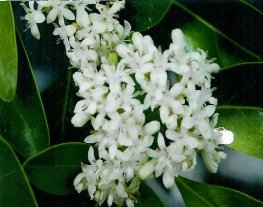Plant species
Below is information on the plant species available at pick up on February 19, 2022. Information and photos by Hui Kū Maoli Ola.
Alaheʻe | Scientific Name: Psydrax odoratum
An indigenous large tree (20-30 ft.) with glossy green leaves and small, white, highly fragrant flower clusters. As the tree grows, it has a radially symmetric growth pattern to it, somewhat like a Christmas Tree, which by the way, it subs as an excellent one! The name alaheʻe means slippery/wandering fragrance. It gets this name because when in full bloom, the plant is completely covered in flower clusters and many times you’ll smell the plant before you actually see it.
Distribution: This indigenous tree is found in the dry to mesic forests on all the main islands except Niʻihau and Kahoʻolawe. In certain localities you can still find this plant along the coast.
Cultural Uses: Digging tools and adze handles were made from the hard wood of this plant while a black dye was also made from the leaves. In addition, the flowers and fruit are used in lei.
Landscape Uses and Care: Alaheʻe loves full sun and or partial shade and requires minimal watering once plant is established in the ground. Looks great as a single specimen plant or even used as a hedge.
Kokiʻoulaula | Scientific Name: Hibiscus kokio
Description: A typical hibiscus shrub (4-10 ft. tall) with extremely glossy, dark green leaves and small red hibiscus flowers. This species, as well as Hibiscus clayi, are the only types of red hibiscus that are native. All of the other red hibiscus that are seen in landscapes are introduced and/or are hybrid cultivars.
Distribution: This species is found sparingly in the dry-wet forests of all the main islands except Niʻihau and Kahoʻolawe.
Landscape Use and Care: This plant makes good for a hedge or specimen plant for your garden. It prefers full sun to partial shade and does best in well drained soil. Few pests bother this plant except for the occasional white-fly or aphid. Store bought pesticides should control the problem should it arise. Every other day watering is sufficient.
Cultural Uses: The flowers of this plant were used as a mild laxative and as a dye.
Maʻo hau hele | Species name: Hibiscus brackenridgei subsp. molokaiana
Description: A shrub (up to 10 ft.) with maple like leaves and bright yellow hibiscus flowers. This plant varies in appearance between islands but generally falls into three subspecies: H.brackenridgei subsp. brackenridgei of Maui, Molokaʻi, Lanaʻi, and Hawai’i and H. brackenridgei subsp. mokuleianus of Oʻahu and Kauaʻi and H. brackenridgei subsp. molokaiana of Molokaʻi and O’ahu. The most visible difference between the three subspecies is in the leaves and stems. Subspecies mokuleianus has leaves with more serrated margins and pink veins; there are also tiny spines on the branches. Meanwhile, subspecies brackenridgei has leaves with more rounded margins, yellow veins and lacks the tiny spines on the branches. This particular subspecies came from Mākua Valley on Oʻahu where it was only recently discovered and posses characteristics of both subspecies making it very appealing. Its leaves resemble those of the subspecies brackenridgei but with pink veins like subspecies mokuleianus and although it is from Oʻahu, it lacks the branch thorns of subsp. mokuleianus which is a good thing cause those little pricks can hurt.
Distribution: This is an endemic species found only in Hawaiʻi, it is also an endangered species with very few populations left in the wild. They are usually found in the dry to mesic forests of all the main islands except Niʻihau (it was once reportedly collected from Kahoʻolawe but now it no longer exists there).
Landscape Uses and Care: This plant does well in full sun to partial shade and needs very little water to thrive although daily watering is okay. It is a fast grower and will flower twice a year. Each flowering period lasts up to two months with blooms occurring daily on a flowering stalk that rises up above the rest of the plant. Unlike most hibiscuses, this plant doesn’t perform well as a hedge. Instead it looks best as a specimen plant. Rose beetles may attack the leaves of maohaohele at night and leave them looking like Swiss cheese. To prevent this, planting it near a light source at night should help. It seems that plants which are normally affected by rose beetles aren’t affected as much when they are either planted near landscape lighting or under a bright streetlamp or porch light. Leave the lights on from dusk until at least 8 or 9 at night and that should keep those nasty munchers away. Occasionally, whiteflies may be found under the leaves, any store bought pesticide should remedy that problem.
Additional Info: The name of this plant, ma’o hau hele, literally means the “traveling green hau”. It is probable that it got this name because after the plant gets to be about 3-5 years old it will become top heavy and either lean over or fall over and sprout new roots where the leaning branches touch the ground. Sometimes the old portion of the plant will die and the newly sprouted roots from the leaning branches will make the same plant thrive in a new spot a few feet over from its original location. Over time if the plant continues to flop over and sprout new roots it can move quite some distance. Sierra Club of Hawaiʻi founder, Lorin Gill, recalls a particular maʻo hau hele traveling over 20 ft in about 15 years! In 1988, the State of Hawaiʻi changed the state flower from the native red hibiscus (Hibiscus kokio) to this one. It should be made clear that this is the only species of yellow hibiscus that can be called our state flower, all other yellow hibiscus are not.
Information and photos by Hui Kū Maoli Ola.




